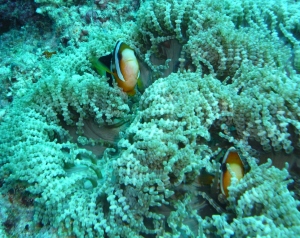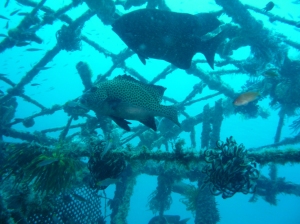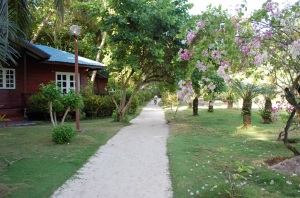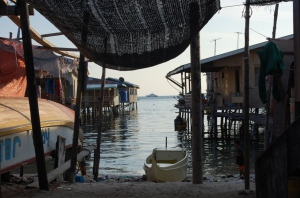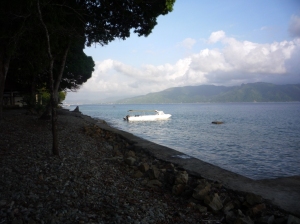I first heard about Sipadan before I took up diving. A backpacker told me about this amazing island with powder sand beaches, clear waters teaming with marine life and a 800 metre drop off (underwater cliff). Others may have heard of Sipadan after the 2000 kidnapping of 21 people from a Sipadan dive resort. Nowadays there are no resorts on Sipadan island. Daily access for divers and visitors is strictly controlled via a permit system and the island is discreetly well protected …
 My buddy Lynn and I decided to finally add Sipadan to our log books and booked up a week of diving at Borneo Divers. They were the first to set up a dive centre in Sipadan back in 1984. Borneo Divers in 1996…
My buddy Lynn and I decided to finally add Sipadan to our log books and booked up a week of diving at Borneo Divers. They were the first to set up a dive centre in Sipadan back in 1984. Borneo Divers in 1996…
Sipadan no longer has resorts, partly as a result of the kidnapping but mainly because of application criteria for UNESCO World Heritage recognition. Most divers stay at Mabul island, about a 20 minute boat ride away. There are three main dive areas in and around Sipadan:
- Sipadan Island – reef diving
- Mabul Island – muck and natural reef diving
- Kapalai Reef – muck, shallow reef and artificial reef diving
Sipadan 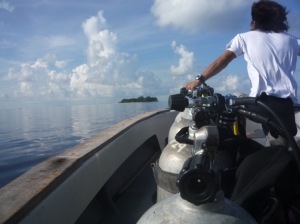 My buddy Lynn and I were fortunate enough to get three days of diving at Sipadan. More about the permit system towards the end of the post. When we dropped in and found ourselves among a huge school of jacks, we both knew Sipadan lived up to its reputation and place as a world-class dive destination. From then on, almost every dive, we saw turtles, white-tipped sharks and lots of schools of pelagic fish – and great visibility …
My buddy Lynn and I were fortunate enough to get three days of diving at Sipadan. More about the permit system towards the end of the post. When we dropped in and found ourselves among a huge school of jacks, we both knew Sipadan lived up to its reputation and place as a world-class dive destination. From then on, almost every dive, we saw turtles, white-tipped sharks and lots of schools of pelagic fish – and great visibility …
The greatest abundance of fish were found at the most aptly named site Barracuda point. It’s hard to describe how wonderful it feels to be in the middle of such large schools of amazing fish. It really is like being in a huge bowl of live fish soup! In their excitement, many divers head straight over to the fish, but if you just “hang out” in the blue watching, they come to you…
Other schooling pelegics included masses of jacks and trevallys …
The topography at the drop off site was pretty amazing too…
I thought I was seeing double here with these pennant fish – but there were plenty more…
Another cute pair – fire dart gobies … 
..and reef stalwarts – anemone fish ..
This piece of mooring debris also caught my attention – beautiful soft coral has converted it to a small hanging artificial reef! 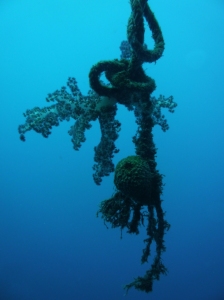 On our last Sipadan diving day, our group included Derek, Alan and Ben. Derek took some great go-pro footage and made this nice video clip…. http://www.youtube.com/watch?v=Enbumto0BkE We dived four times each day at Sipadan. Surface intervals are spent at what remains of the resort. Toilets, showers and picnic facilities are on the island, with each resort bringing in food and beverages each day. There are also a few sunbeds.
On our last Sipadan diving day, our group included Derek, Alan and Ben. Derek took some great go-pro footage and made this nice video clip…. http://www.youtube.com/watch?v=Enbumto0BkE We dived four times each day at Sipadan. Surface intervals are spent at what remains of the resort. Toilets, showers and picnic facilities are on the island, with each resort bringing in food and beverages each day. There are also a few sunbeds.  Mabul The sites around Mabul offers a contrast to Sipadan, both in terms of topography and marine life. As you can see from the images, the visibility isn’t as good as Sipadan, but there are some pretty reefs on the western side of the island, with the others mostly muck diving sites. My favourite Mabul site was under the Sea Adventures dive resort – a converted oil rig. Guaranteed sightings on every dive includes a resident giant grouper, crocodile fish and scorpion fish …
Mabul The sites around Mabul offers a contrast to Sipadan, both in terms of topography and marine life. As you can see from the images, the visibility isn’t as good as Sipadan, but there are some pretty reefs on the western side of the island, with the others mostly muck diving sites. My favourite Mabul site was under the Sea Adventures dive resort – a converted oil rig. Guaranteed sightings on every dive includes a resident giant grouper, crocodile fish and scorpion fish … 
I was also very lucky on one dive – not a very good shot, but this is a painted clown frog fish – about the size of a small fingernail. I have only seen one other during my nine years diving…  I was also fortunate to see a robust ghost pipe fish. Ghost pipe fish are masters of disguise and this one was mimicking a rotting palm leaf. From a slightly different angle, you can clearly see it is from the pipe fish family…
I was also fortunate to see a robust ghost pipe fish. Ghost pipe fish are masters of disguise and this one was mimicking a rotting palm leaf. From a slightly different angle, you can clearly see it is from the pipe fish family…
Ornate ghost pipe fish can also be found at this site  The other sites at Mabul are more scenic, although offer less diversity than Sea Adventures. I saw a lovely pygmy sea-horse – again, not such a good picture, but it is the best I have taken of a pygmy sea-horse with a point and shoot! For those unaware, these are about the size of a fingernail tip!
The other sites at Mabul are more scenic, although offer less diversity than Sea Adventures. I saw a lovely pygmy sea-horse – again, not such a good picture, but it is the best I have taken of a pygmy sea-horse with a point and shoot! For those unaware, these are about the size of a fingernail tip!  The only other experience I am reporting, in the interests of public awareness, is myself and my buddy were attacked by a titan trigger fish after unwittingly straying into its nesting cone.
The only other experience I am reporting, in the interests of public awareness, is myself and my buddy were attacked by a titan trigger fish after unwittingly straying into its nesting cone.

Graphic Credit: http://fishileaks.wordpress.com/
This happened at our safety stop in the shallows. I was oblivious and looking in a different direction. First it bit my fin, and Lynn heard me yell. As I was telling her what happened, it bit my right shin, then her fin. We swan off that reef like a pair of torpedoes! I was wearing my full length wetsuit, which gave me protection from the bite – a bruise and small graze was all that I sustained thankfully. I got a huge fright though! I have since learnt that titan trigger fish nest during the full moon period – and I wont forget this now!
Kapalai
This is a reef a couple of kilometres from Mabul island. A resort on stilts sits above the reef and a number of dive sites surrounds it, offering shallow and easy diving. The sites I dived had artificial reefs – and some are rather creative…
It was fun looking around them for the small stuff. Here’s Lynn coming down “Wendy House Lane”…
As with all muck diving, when you have a closer look, you can find marine life treasures, like this flamboyant cuttle fish.
…and this family of desirable and red line Flabellina nudibranches (ID thanks to my UW Photography friend ScbubaShafer)
At first glance, this is just a boat load of old bottles…
… but looking more closely at junk like this, you’ll find life. This blenny was a real character bobbing in and out of his home …
This dive trip will also be remembered for discovering a brand new and very charming species – the lesser spotted pink or blue Oriental sweet pair. They are often spotted in Mabul and Sipadan, due to an easy vacation migration route linking Shanghai to Kota Kinabalu airport…
Please note the unusual markings that makes identification easy – matching regulator hoses, snorkel, booties, fins, steel prodder….. Underwater, the female species also adorns herself with mouse ears. Others chose bunny or bug ears.
Other divers from the region were equally spell-bound by this new species from China. I do hope they do something about shark finning!
So, a summary of the sites we dived:
Sipadan – 12 dives
- Barracuda Point (3)
- Shark, or South Point (3)
- Drop Off (2)
- Turtle Cavern (2)
- Hanging Garden (1)
- Coral Garden (1)
Mabul – 13 dives
- Borneo Divers House Reef/Paradise II (4)
- Sea Adventures (3)
- Lobster Wall (2)
- Eel Garden (2)
- Ray Alley (2)
Kapalai (2)
- House Reef (1)
- Mandarin Gardens (1)
Overall
The diving on Sipadan exceeded my expectations – it really is outstanding. I heard so many mixed reports and was also put off by the uncertainty that comes with a permit system. Notwithstanding this however, it was worth it. The diving at Mabul is also good enough and is on the “dive map” as a muck diving destination – check my post here. More and more resorts are opening on a burgeoning Mabul and they are starting to build stilted resorts on neighbouring reefs, so my advice is to go, but go soon before it gets too crowded.
How to get to Sipadan
By air, road then boat. The closest airport is Tawau. Air Aisa and Malaysian Airlines offer flights from both KL and Kota Kinabalu, which is the main international airport for Borneo. From Tawau, it is another one hour by road to the jetty at Semporna, and a further hour by fast boat to Mabul. Borneo Divers offer a free road and boat transfer at set times of the day. Outside of these times is extra.
How long to go for – the permit system
Although necessary to keep the island and its fragile eco-system pristine, diving at Sipadan is a bit of a lottery because of a day permit system. Introduced in 2006, 120 permits are issued each day and there’s a quota system for the 12 dive resorts. Permits are 40 Malaysian Ringgit each (approx £8 or $13) and are applied for in advance, via your resort. The issuing authority is Sabah Parks, but you wont find any information on their website. The number of Sipadan dive days offered depends on the length and location of stay. The most important criteria for choosing the length of stay at Mabul is the resort’s policy on Sipadan permits. A three-day stay normally guarantees you a one day permit. Here is the list of the quota per resort, taken at the permit office on Sipadan late April 2014 – it seems the numbers change daily, but you get a gist of who gets the most permits ….
Where to stay
There is a growing range of options on Mabul catering from backpackers right up to luxury travellers. We chose Borneo Divers due to its reputation, availability, speed of response from their sales team and cost (mid-priced). We booked eight nights, seven days diving, as this guaranteed us two days at Sipadan. We got lucky with three. Overall we were very happy at Borneo Divers. It’s and extremely well run in a confident, yet understated manner – things just happened. The resort was clean and well-kept, food excellent and the dive operations were flawless. The only down side was poor wi-fi – but is that important on a dive holiday? My verdict – the original, and the best operators.
A look round Borneo Divers
Arrival briefing
The dive deck and store-room
The dive sites, with dive guide Willy (left) and Amin, the man that keeps everything running safely and smoothly
The dive staff, including the elusive dive head hauncho LJ ( so if you want extra day of diving at Sipadan, tell him he’s handsome!)
The daily dive schedule – this is completed every afternoon for the following day, so divers know their boat and dive guide, where it is going and what time to be on the dive deck. Simple. Effective. Perfect.
Borneo divers house reef, with Sea Adventures in the distance. That boat is due to be sunk in June and will be the latest addition to the dive site listing at Mabul. Borneo Divers offers unlimited diving on the house reef, which is very good!
Our chalet and the grounds …
The reception area and dining room …
… and finally a little slice of island life….
















